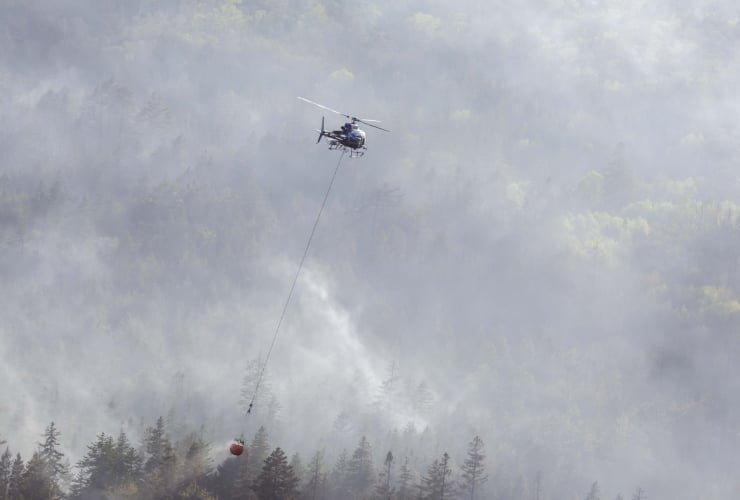HALIFAX — For the second time in the past seven years, Danny Osborne has fled his home because of a wildfire.
In May 2016, he escaped the devastating fires in Fort McMurray, Alta., which forced the evacuation of 90,000 people and destroyed 2,400 homes and businesses. But his Alberta home survived the disaster.
But on Tuesday, Osborne learned the Halifax-area wildfire that has been burning since Sunday had claimed his new residence in Nova Scotia.
He was among a group from the Yankeetown subdivision northwest of Halifax who were led by RCMP to see what remained of their properties after the wildfire swept through.
"It’s gone," the 45-year-old construction worker said after he returned from seeing his gutted home. "It is completely flattened."
Osborne recalled how when he left his house after an evacuation was ordered, he saw black, churning smoke in his rear-view mirror and felt the same "gut-wrenching" emotions he endured during the Alberta disaster.
“It’s just chaos, and it’s happening all over the country,” said the father of two, his voice flat and fatigued. “This time, I think I was a little calmer as I’ve been through it before. But it was still very, very scary. It’s the second time I’ve pulled my camper away from a forest fire to live in it.”
Earlier in the day, fire officials said that with the return of dry, windy conditions, there could be a "reburn" in the evacuated subdivisions, which are spread out over 100 square kilometres.
"We are expecting a significant level of fire behaviour," David Steeves, a forest resources technician with Nova Scotia’s Department of Natural Resources, told reporters at a command post in Upper Tantallon, N.S.
"It's going to be an increasingly dangerous situation for the firefighters who are on the ground."
Halifax deputy fire Chief David Meldrum said firefighters had spent the night extinguishing hot spots in neighbourhoods where 200 homes and structures have been damaged since the fire started. It remains unclear how many homes have been destroyed because surveys have yet to be completed.
In all, about 16,000 people have been ordered to leave their homes in the Halifax area, most of which are within a 30-minute drive of the port city's downtown.
Premier Tim Houston announced the province would be banning all travel and activity in all wooded areas as of 4 p.m. local time.
“For God’s sake, stop burning. Stop flicking your cigarette butts out your car windows. Just stop it,” Houston said, adding that conservation officers caught six people setting illegal fires on Monday night alone.
The ban applies to all forestry, mining, hunting, fishing, hiking, camping, off-road vehicle driving and all commercial activity on Crown lands, he said.
“We’re in a very serious situation in this province, and we need to take the steps that we can to protect Nova Scotia,” he told a news conference via a video call from Shelburne, N.S., where the largest wildfire in the province has been burning since the weekend.
“I wanted to get a sense of the damage here,” the premier said. “It’s extensive. It’s heartbreaking.”
In all, 2,000 people have been evacuated from their homes in southwestern Nova Scotia as the 100-square-kilometre fire northwest of Barrington, N.S., continued to grow Tuesday. The wildfire was one of three burning out of control across the province, along with the fire near Halifax and a much smaller fire near East Pubnico in the southwestern corner of the province.
Scott Tingley, manager of forest protection with Nova Scotia’s Department of Natural Resources, said the blaze near Barrington was proving to be very challenging. “We do have communities and homes at risk as we speak,” he said.
In the Halifax area, with southwesterly winds gusting at 30 kilometres per hour on Tuesday, the concern was that the eight-square-kilometre fire northwest of the city would retrace its original route and set fire to what hasn't already burned, Steeves said.
Trees and other flammable materials in the affected subdivisions have been "cured" by extreme heat, which means they will readily ignite if the fire returns, he said.
"The fuels that haven't been consumed the first time that the fire went over, now are ready to burn," he said. "The possibility of reburn ... could create a very dangerous environment .... That’s why it’s so important for folks to respect the evacuation zones and stay out.”
Meanwhile, the extended forecast is calling for hotter weather on Wednesday and Thursday, and no rain until Friday night at the earliest.
As homeowners wait to learn the fate of their evacuated residences, questions are being raised about the response of firefighters and their access to fire hydrants in the sprawling subdivisions.
Meldrum said the fire on Sunday was moving so quickly that firefighters didn't have time to worry about hydrants.
“Keeping up with the fire during Sunday’s events was more about the speed of the fire and our ability to get resources on the flanks of that fire and less about the availability of water," he said.
On Sunday, Halifax Fire district Chief Rob Hebb said his firefighters were at times being overrun by the advancing flames and had to quickly pull back to ensure their safety. “It was chaotic," Meldrum added Tuesday. "It was an extreme event.”
Fire officials were asked about the inherent dangers in building massive subdivisions that have limited road access and remain exposed to large wooded areas, something Meldrum referred to as the "wildland-urban interface.”
“We all enjoy the beauty of nature," he said. "But as we build deeper into what used to be forested land, consideration must be made for (installing) lots of places for firefighters to get water, (and building) many routes in and out of communities.”
In September 2021, Halifax's auditor general released an audit saying management with Halifax Regional Fire and Emergency had noted certain subdivisions were built with "inadequate water sources" to fight fires. Among the subdivisions flagged for concern was Westwood Hills in Upper Tantallon, the same neighbourhood where the wildfire started on Sunday.
The report said the fire department confirmed there was a project in the works to install so-called dry fire hydrants in these subdivisions. These hydrants are not connected to the pressurized municipal water supply but are instead linked to a water source, such as a lake, which requires a pumper truck to extract the water.
As of Tuesday, Halifax Regional Fire and Emergency had six fire engines, 10 tanker trucks and 60 firefighters battling the fire, with the help of crews aboard three helicopters.
This report by The Canadian Press was first published May 30, 2023.
— With files from Keith Doucette
The same fires could happen
The same fires could happen here in Ontario if we allow sprawling subdivisions to cut into the Greenbelt.





Comments